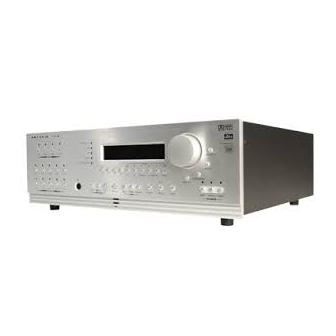Advertisement
4. CONNECTIONS
4.1
CONNECTING POWER TO THE AVM 20
Connect the power cord to the back of the AVM 20 and then to a 105 to 130 Volt, 60 Hz AC outlet.
4.2
AUDIO CONNECTIONS
There are two methods of transmitting audio signals: Analog and Digital. Analog is an electrical waveform
representation of sound and requires one cable for each channel. Digital represents sound using a sequence
of numbers and requires only one cable for all channels.
Every audio input in the AVM 20 can be changed from the factory setting to either Digital or Analog, except
2-Ch BAL and 6-Ch S/E, which accept analog signals only (see section 7.4.2).
4.2.1 DIGITAL AUDIO INPUTS AND OUTPUTS
Digital Audio-In connections are made through a coaxial (RCA), optical (TOS), or balanced (XLR) cable. From
the factory, DVD and SAT are set to Digital-RCA, whereas CD, TAPE, TV, VCR, and AUX are set to Analog-DSP.
The highest transmission quality is achieved with the AES/EBU-XLR connection. The AVM 20 provides one
such connection which may be assigned to any Source, except 2-Ch BAL and 6-Ch S/E. The S/PDIF-RCA
connection offers the next best digital transmission – use for source components with digital RCA outputs.
For source components with Toslink outputs only, use S/PDIF-TOS connections (remove dust cover before
connecting). These may also be assigned to any Source, except 2-Ch BAL and 6-Ch S/E (see section 7.4.2).
Note: An external RF demodulator is required if using a Laser Disc player with Dolby Digital/AC-3.
Digital Rec-Out can provide a signal to the digital audio input of a Mini Disc recorder, CD-R, etc., from any
Source set to 'Digital' or 'Anlg-DSP', except 6-Ch S/E (see sections 7.4.2 and 7.4.3).
4.2.2 ANALOG AUDIO INPUTS
Left/Right Analog audio connections are made through a pair of interconnect cables – typically white or
black for the Left channel and red for the Right channel. The audio output connectors on tape recorders,
VCRs, and CD players are normally color coded in this same manner.
Note: Connect both the digital and analog outputs from source components that have both types of
connection (e.g. DVD player) – ZONE2, ZONE3, and RECORD require analog audio connection
unless set to 'copy' MAIN (see section 5.2.1).
16
Advertisement
Table of Contents

Subscribe to Our Youtube Channel
Summary of Contents for Anthem AVM 20
- Page 1 4. CONNECTIONS CONNECTING POWER TO THE AVM 20 Connect the power cord to the back of the AVM 20 and then to a 105 to 130 Volt, 60 Hz AC outlet. AUDIO CONNECTIONS There are two methods of transmitting audio signals: Analog and Digital. Analog is an electrical waveform representation of sound and requires one cable for each channel.
-
Page 2: Analog Audio Outputs
– connect DVD-A player video output to the DVD input (sections 4.3 and 7.4.2). The 2-Ch BAL and 6-Ch S/E inputs can be set to either bypass all digital stages in the AVM 20 or to include digital stages, so that bass management, time alignment, bass/treble control, surround modes, and THX post- processing can be enabled (see sections 5.7, 5.8, 7.4.2, and 7.4.5). -
Page 3: Video Connections
Note that video format conversion is not performed – if S-Video is used from your VCR, only the S-Video output of the AVM 20 will have a signal to send to your TV monitor whenever the VCR Source is selected. - Page 4 4. CONNECTIONS continued … DVD Player, Satellite Receiver, and TV Connections with AVM 20 as Video Input Selector Rear Panel of TV Audio Relay Composite CATV Trigger Video In Component Video In Vari Fixed S-Video In SATELLITE Note: Component Video use is optional (see sections 4.3.3...
-
Page 5: Powered I.r. (Infra Red) Receivers
Note: For installers – The AVM 20’s IR inputs sense pulses from an IR repeater, not data. If using a control system that sends IR data, an emitter must be used face-to-face with an IR repeater.

















Need help?
Do you have a question about the AVM 20 and is the answer not in the manual?
Questions and answers